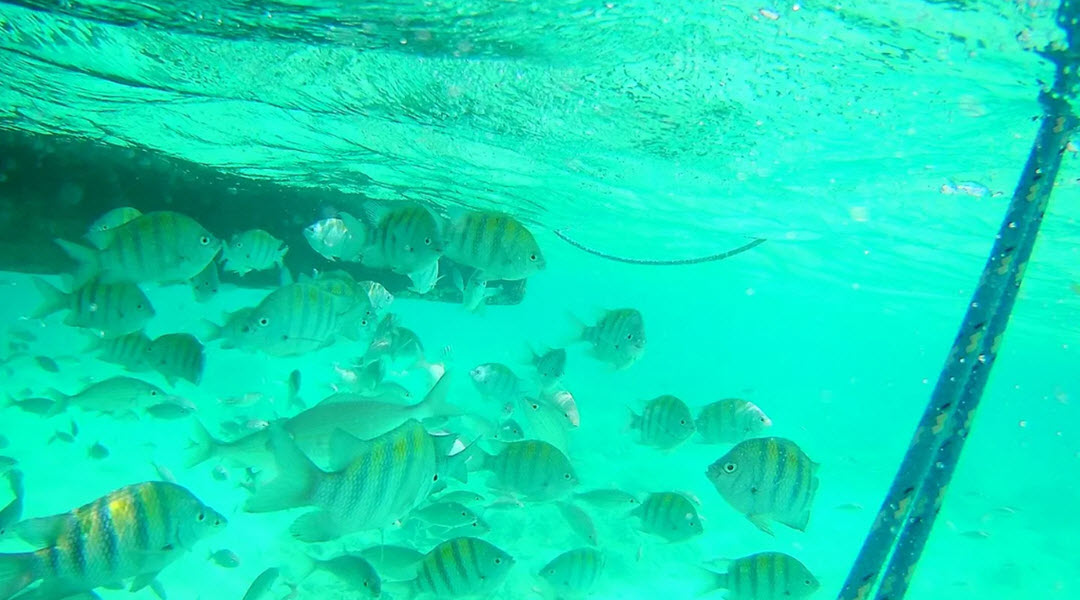Sea Life You Can See on an Aruba Catamaran Snorkel Tour

Aruba’s reefs teem with creatures that’ll make you forget about your surface worries. We’ve watched first-time snorkelers become instant ocean advocates after meeting their first parrotfish or turtle. Our catamaran snorkeling excursions hit the sweet spots where wildlife naturally lives.
Sea Turtles in Aruba Waters
Turtle Behavior and Habitat
Green turtles munch seagrass in 8 to 15 feet of crystal-clear water, weighing anywhere from 240 to 400 pounds while measuring 3 to 4 feet nose to tail. Between March and November, they practically own certain coral areas we frequent. Their slow, methodical swimming style means you can drift alongside without spooking them.
Your guide recognizes their preferred grazing zones and knows exactly where to position everyone for those heart-stopping encounters. The deliberate way they move through water makes time feel suspended.
Best Viewing Opportunities
- Dawn and dusk feeding sessions offer prime sighting windows
- Seagrass meadows in shallow zones provide ideal conditions
- Sandy clearings between corals serve as resting spots
- Peak season runs from March through November for consistent encounters
When a turtle glides past your mask, it creates a memory you will treasure for a lifetime.
Tropical Fish Species
Blue Parrotfish
Blue parrotfish work Aruba’s reefs like living jackhammers, chomping coral all day then producing the white sand beaches tourists love. These 3-foot beauties cruise between 6 and 20 feet deep, creating that distinctive crunching sound that carries underwater. Groups of them move together, their electric blue scales catching sunlight like underwater jewels.
Your guide explains wild biological facts while pointing out different parrotfish species. The sound alone helps locate them before you spot that unmistakable neon coloring.
Angelfish and Small Reef Fish
Queen angelfish strut around their territories like underwater royalty, flashing yellow and blue patterns that photographers dream about. French and gray varieties add their own flair, each sporting distinctive markings that make identification surprisingly easy. These 10 to 18-inch characters often swim right up to investigate snorkelers.
Butterflyfish and sergeant majors zip through shallow coral gardens like caffeinated sprites, working depths perfect for beginners still figuring out their gear.
- Distinctive eye spots and stripes make identification entertaining
- Feeding patterns shift between coral zones and sandy areas
- Small groups dart between brain coral and sea fan formations
- Angelfish curiosity often leads to close-up encounters
These tiny performers measure 3 to 8 inches but pack a serious visual punch.
Predatory Marine Life
Moray Eels
Green morays hide in coral crevices like secretive underwater residents, reaching 6 feet long while typically displaying only their recognizable heads. These serpentine creatures inhabit depths between 10 and 65 feet, remaining totally safe unless bothered. Hot midday sun drives them into deeper coral shelters, but cooler hours draw them toward shallower gaps.
Your guide spots telltale signs of moray presence before pointing out those unmistakable heads emerging from reef openings. Their prehistoric appearance commands respect without inspiring fear.
Barracuda and Open Water Hunters
Barracuda patrol deeper zones near coral heads and shipwrecks, typically between 15 and 50 feet down. Most sightings involve juveniles rather than the full-sized 5 to 6-foot adults, but even smaller ones display that classic predator profile with reflective silver bodies and pointed jaws.
- Solitary behavior keeps encounters at comfortable distances
- Quick movements demonstrate apex hunting capabilities
- Healthy populations indicate thriving ecosystem conditions
- Wreck sites provide consistent barracuda viewing zones
These living torpedoes command attention whenever they cruise through snorkel areas.
Bottom-Dwelling Creatures
Rays and Skates
Stingrays and eagle rays transform sandy bottoms into flight demonstrations, gliding through 15 to 30-foot zones where sand meets coral. Eagle rays show off spotted patterns while reaching 6-foot wingspans that create dramatic silhouettes against bright sand. Stingrays bury themselves during peak sun hours, emerging later for active periods.
Both species tolerate human presence beautifully, creating spectacular wildlife viewing without stress. Your guide positions groups for optimal angles while respecting natural behaviors.
Grouper and Snapper
Thick-bodied grouper and snapper claim areas around coral bases and stone outcrops throughout 10 to 40-foot zones. These 2 to 4-foot fish show vibrant reds, browns, and yellows that pop against reef backgrounds. Less crowded spots reached via private boats typically produce superior viewing because fewer people allow normal activity.
- Predictable territorial habits create reliable viewing opportunities
- Vibrant colors stand out dramatically against reef backgrounds
- Private excursions provide access to less disturbed viewing locations
- Predatory roles maintain healthy reef fish populations
Ray encounters feel like witnessing underwater ballet, while these reef sentinels demonstrate ecosystem balance through their hunting patterns.
Coral and Invertebrates
Living Coral Formations
Brain and staghorn corals build underwater metropolises beginning at 4-foot depths and descending along 30-foot walls. These limestone architects create complex three-dimensional neighborhoods housing numerous tiny fish, crustaceans, and invertebrates seen only through close inspection. Dawn illumination filters through most clearly, exposing fine details frequently overlooked during noon excursions.
Thriving coral areas mark ideal snorkeling zones while showcasing ecological roles vital for reef health.
Sea Stars and Sea Urchins
Crimson cushion sea stars dot sandy patches starting around 6 feet deep, while spiny sea urchins wedge into rocky reef cracks seeking protection. Both contribute crucial maintenance services through algae consumption and coral surface cleaning. They appear at virtually every snorkel stop, perfect for teaching marine identification basics.
- Cushion stars prefer sandy clearings between coral formations
- Spiny urchins seek shelter in rocky reef crevices
- Observation requires hands-off approach for mutual safety
- Cleanup roles include algae control and coral maintenance
These hardworking invertebrates add movement and color to sandy areas while maintaining the delicate ecological balance, keeping Aruba’s reefs healthy and vibrant for future generations of snorkelers.
Book Your Aruba Snorkeling Adventure Today
Meet Aruba’s incredible marine life when you’re ready. Reserve your catamaran snorkel tour today and discover why these underwater encounters create a lifetime of vacation memories.
